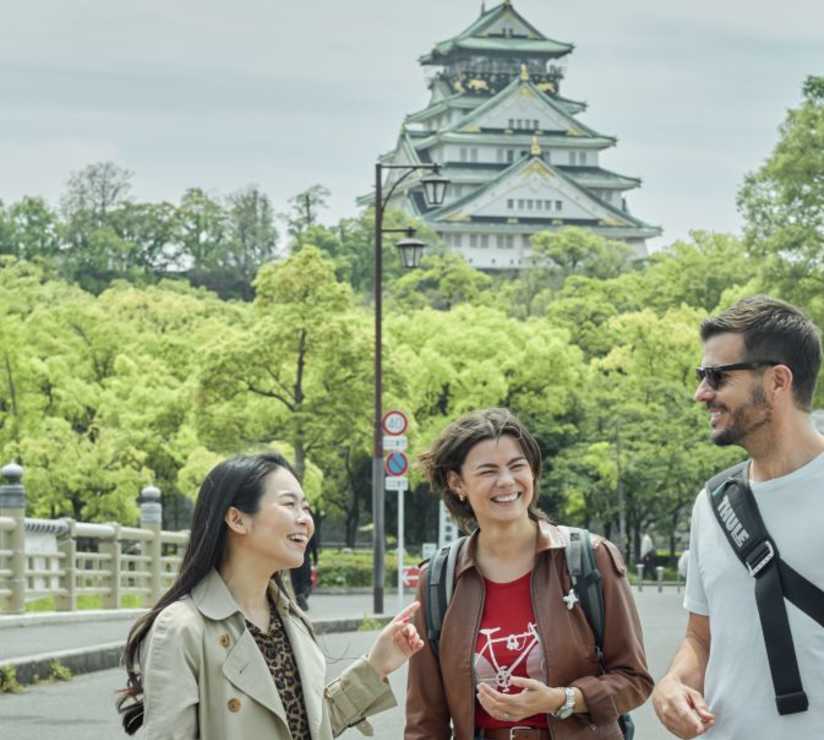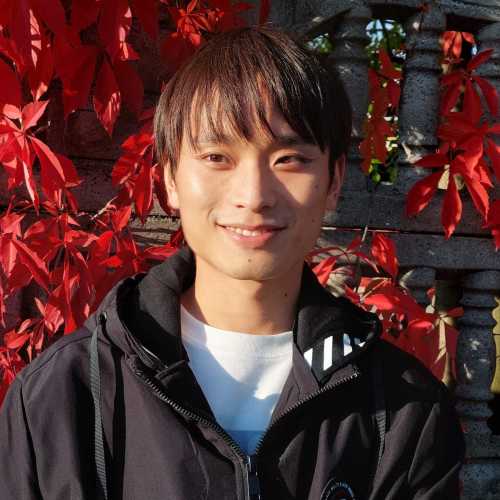We did a 3-hour walking tour in Osaka with Maria. It was a very fun way to get acclimated into a city we have never been to before. At our request, she took us around to the local spots for food, entertainment, and shopping.Skyler, Osaka, 2025
Table Of Contents
- Introduction to Osaka: The City That Sizzles in Summer
- The Real Deal on Osaka's Summer Weather
- Preparing for Your Trip: Summer-Ready in Osaka
- Getting Around Osaka: Navigating the City Heat
- Morning Magic at Osaka Castle Before the Heat Hits
- Universal Studios Japan: Yes, Even in Summer
- Umeda Sky Building: Where Locals Catch Sunset Breezes
- The Food Scene: Why Summer Eating in Osaka Hits Different
- Festival Season: When Osaka's Streets Come Alive
- Cool Escapes: Where to Beat the Heat Like a Local
- Night Moves: When Osaka Really Comes Alive
- Day Trips: Escaping the City Heat
- The Local's Summer Survival Guide
- Why Osaka Summers Beat the Rest
- Quick Reference: Must-Do Summer Experiences
- Essential Japanese Phrases for Summer Survival
- The Bottom Line on Summer in Osaka

Crowded summer festival street in Dotonbori with food stalls Photo by Haugenzhays Zhang on pexels
Look, I get it. When July hits Osaka, the humidity wraps around you like a wet towel fresh from the dryer. But here's what tourists miss: this city comes alive in summer like nowhere else in Japan. The streets pulse with festival energy, the food scene explodes with seasonal specialties, and locals know exactly where to find those perfect pockets of cool air between adventures.
I've spent 35 summers in this city, from sticky childhood days catching cicadas in Osaka Castle Park to late nights at rooftop beer gardens with the skyline glowing orange at sunset. Trust me when I say summer here isn't just bearable, it's when Osaka shows its true colors.
Introduction to Osaka: The City That Sizzles in Summer
Osaka isn’t just another stop on your Japan itinerary - it’s the city that turns up the heat, both literally and figuratively, when summer rolls around. This bustling city pulses with energy, from the neon-lit streets of Dotonbori to the tranquil grounds of Osaka Castle, where centuries of Japanese history meet the modern skyline. Whether you’re chasing the stunning views from the castle’s ramparts or braving the thrilling rides at Universal Studios Japan, there’s no shortage of exciting attractions to keep you moving (and sweating) all day long.
But Osaka’s appeal goes beyond its top attractions. The city’s vibrant nightlife is legendary, with izakayas and karaoke bars buzzing until the early hours. If you time your visit right, you might catch the cherry blossom season in April, when parks and riversides are painted pink and locals gather for hanami parties. And thanks to conveniently located train stations like Osaka Station and Namba Station, hopping between neighborhoods, or even squeezing in a day trip, is a breeze. Whether you’re here for the culture, the food, or the festivals, visiting Osaka in summer means diving headfirst into a city that never slows down, no matter how high the temperature climbs.
Experiences Created by Locals, Just for You
See the city through the eyes of the people who call it home.

Locals cooling off with shaved ice at a street vendor Photo by Saya Kimura on pexels
The Real Deal on Osaka's Summer Weather
Let’s not sugarcoat it. July through August, we’re talking 35°C (95°F) with humidity that’ll have your clothes sticking to you by 9 am. But that’s exactly why locals have perfected the art of summer survival here.
The secret? Start early, take midday breaks, and know where the air conditioning flows strongest. Every convenience store becomes your friend. Every underground shopping arcade offers sweet relief. Many summer events, such as festivals and fireworks, take place outdoors, so staying hydrated and comfortable is especially important during these occasions. And those hand fans old ladies carry? Get one. Pride goes out the window when sweat’s dripping down your back.
Preparing for Your Trip: Summer-Ready in Osaka
Before you set out to visit Osaka, a little preparation goes a long way toward making your summer adventure a breeze. The city’s heat and humidity are no joke, so don’t forget to add sunscreen, a wide-brimmed hat, and a pair of sunglasses to your packing list. A lightweight umbrella is your best friend, shielding you from both the blazing sun and those sudden, dramatic rain showers that sweep through in July and August.
Getting into the city from Kansai International Airport is a snap, especially if you grab a limousine bus ticket or a train pass for a smooth, air-conditioned ride straight into the heart of Osaka. Once you’re settled, dive into local life by wandering through Kuromon Ichiba Market, where the scent of fresh seafood mingles with the chatter of vendors and the sizzle of street food. For a deeper taste of Japanese culture, sign up for a cooking class and learn the secrets behind Osaka’s famous cuisine, or slow down with a traditional tea ceremony, an experience that’s as refreshing for the soul as it is for the body. However you choose to explore, don’t forget to leave a little room in your suitcase for unique souvenirs and the memories you’ll collect along the way.
To taste Japanese history, take a day trip to the Namba Yasaka Shrine, one of the city’s oldest temples.
Getting Around Osaka: Navigating the City Heat
Osaka is a city built for explorers, with many of its most exciting attractions just a short walk or train ride apart. In central Osaka, the Umeda Sky Building stands tall, offering jaw-dropping, 360-degree views from its open-air observation deck, perfect for catching a summer sunset or just soaking in the cityscape from the second floor. If the midday heat gets to you, duck into the Osaka Aquarium, where cool, dark halls and mesmerizing sea life offer a welcome escape, or treat yourself to a few hours at Spa World, where you can relax in themed baths from around the globe.
To taste Japanese history, take a day trip to the Namba Yasaka Shrine, one of the city’s oldest temples, or head up the Tsutenkaku Tower for a retro slice of Osaka’s past and more stunning views. The city’s vibrant nightlife comes alive as the sun sets, with bars, restaurants, and hidden gems waiting to be discovered around every corner. Whether you’re tracing the footsteps of Prince Shotoku, sampling fresh sushi, or simply wandering from one air-conditioned oasis to the next, visiting Osaka in summer means you’re never far from your next adventure or your next cool-down spot.
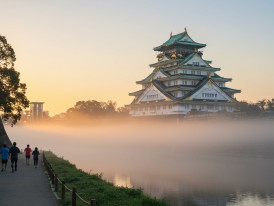
Early morning mist around Osaka Castle with joggers on the path
Morning Magic at Osaka Castle Before the Heat Hits
Here’s my first insider tip: Hit Osaka Castle before 8 am. I’m serious. The grounds open at 6, and watching the sun climb over those ancient stone walls while the city slowly wakes up? That’s Osaka that most tourists never see.
The castle itself doesn’t open until 9, but honestly? The real magic happens outside. Local joggers nod as they pass. Old-timers practice tai chi near the plum grove. By 7:30, you’ve already captured photos without crowds, and the temperature’s still manageable. Later in the day, Osaka Castle attracts many visitors, so the early hours are especially peaceful.
Inside Osaka Castle, the museum tells the story of Japanese history through Toyotomi Hideyoshi’s eyes - the man who essentially built modern Osaka. The observation deck on the eighth floor? Worth every step up, especially when you catch glimpses of the city stirring to life below.
Quick tip: The entrance fee is just 600 yen, and they’ve got blessed air conditioning that’ll feel like heaven after your morning walk.
Travel Guides Can Only Take You So Far
We connect travelers with locals who shape days that actually fit your interests — not someone else’s checklist.
Start planning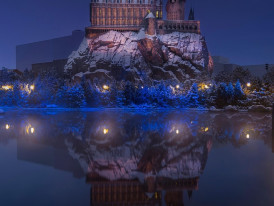
Wizarding World of Harry Potter at dusk with lights beginning to glow. Image by we-o_rd35omj_5fvnk7lro from Pixabay
Universal Studios Japan: Yes, Even in Summer
I know what you’re thinking. Theme park in July heat? Hear me out. Universal Studios Japan pulls out all the stops for summer, extended hours, night parades, and special cooling zones they don’t advertise in English.
Sure, the Wizarding World gets packed, but here’s what most tourists don’t know: Hit it either right at opening or after 6 pm when families with kids start heading home. Butterbeer tastes even better when you’re escaping the heat in Honeydukes’ air conditioning.
Pro move: The Jurassic Park water ride isn’t just a ride in summer, it’s strategic cooling. Get soaked, walk around wet for an hour, repeat. Universal Studios knows this game, which is why they’ve got those full-body dryers stationed everywhere.
There are plenty of other attractions at Universal Studios Japan too, like Spider Man and more Jurassic Park experiences, so you can diversify your visit beyond the main highlights.

Umeda Sky Building’s distinctive architecture against sunset sky Image by
Umeda Sky Building: Where Locals Catch Sunset Breezes
Forget those tourist-trap observation decks in Tokyo. Umeda Sky Building is where Osaka locals go when they need to breathe. The floating observatory sits 173 meters up, connected by those wild escalators that’ll make your stomach flip even before you reach the top. For another perspective on Osaka’s skyline, the city’s giant Ferris wheel offers panoramic views and is a popular sightseeing option.
view of Osaka from Umeda Sky Building observation deck Kuchu Teien Observatory view from below.
But here’s why summer’s actually the best time to visit: that open-air observation deck. Yeah, it’s hot during the day, but come 6 pm? The breeze kicks in, the sun starts its descent, and you’ve got 360-degree views of Osaka transforming from concrete jungle to glittering wonderland.
Tickets run 1,500 yen, but time it right for sunset and you get both day and night views. The basement also hides a recreation of 1920s Osaka streets, perfect for when you need AC and Instagram-worthy shots.
Too Many Lists, Not Enough Clarity?
We make exploring simple by connecting you with someone who knows the city and helps you spend your time on what matters to you.
Traditional tea ceremony setup with summer elements Photo by haijiang zeng on Unsplash
The Food Scene: Why Summer Eating in Osaka Hits Different
Listen, Osaka’s food scene is legendary year-round, but summer brings out flavors you won’t find any other time. The city’s nickname is “Japan’s Kitchen,” and July is when that kitchen really starts cooking. Osaka’s summer specialties are a testament to the adventurous spirit of Japanese cuisine, blending tradition with local innovation.
Kuromon Ichiba Market: Morning Fuel Stop
Start at Kuromon Ichiba Market before 10 am. This 600-meter covered arcade houses 150 shops, and summer means one thing: peak seafood season. The fresh tuna, the sweet shrimp, the sea urchin, everything tastes better when it’s pulled from cool waters while the city sweats.
Some cooking classes in Osaka begin with a guided tour of Kuromon Ichiba Market, giving participants hands-on experience with selecting ingredients and preparing traditional dishes.
My go-to move? Hit up Kuromon Sanpei for their sushi breakfast set. 1,000 yen gets you chef’s choice of the morning’s best catch. The second floor has tables where you can eat above the market buzz, and yes, it’s air-conditioned.
Street Food Paradise in Shinsekai
Come evening, Shinsekai turns into street food heaven. This retro neighborhood around Tsutenkaku Tower knows how to do summer right, cold beer, hot kushikatsu, and locals who'll chat you up if you're brave enough to squeeze into those tiny counter seats.
The rule at kushikatsu joints? No double-dipping in the communal sauce. Break it once, and the whole place will good-naturedly roast you. Trust me, I learned that lesson at 15 and never forgot it.
Tea Ceremony in Summer: A Different Experience
Most guidebooks push you toward tea ceremony experiences, but here's what they don't tell you about summer sessions. The heat changes everything about this Japanese tradition. The tea master chooses lighter utensils, serves a cooler tea temperature, and even the sweets become more refreshing - think water-based jellies instead of dense bean paste.
I stumbled into a summer tea ceremony at Sumiyoshi Taisha shrine five years ago, thinking I'd melt in that traditional room. Instead, the master explained how the entire ritual shifts with the seasons. The scroll in the alcove depicted a waterfall. The flowers were morning glories, picked before dawn. Even the charcoal arrangement in the hearth was designed to produce minimal heat while maintaining the ceremony's essence.
If you're curious about tea ceremony but worried about the heat, summer sessions are actually ideal for beginners. The pace is gentler, the atmosphere more forgiving, and that cold barley tea served afterward? Pure salvation.
Hungry to Taste Osaka Like a Local?
From tucked-away eateries to lively markets, discover flavors worth your time.
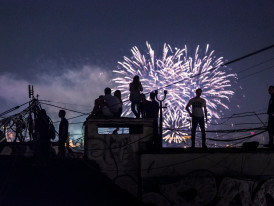
Crowds gathering on rooftops to watch distant fireworks. Photo by Aleksandr Popov on Unsplash
Festival Season: When Osaka's Streets Come Alive
July in Osaka means one thing above all: festival season. And I’m not talking about those sanitized cultural experiences hotels promote. I mean real, sweaty, crowded, incredible neighborhood festivals where half of Osaka seems to spill onto the streets. These lively gatherings are a true reflection of Osaka’s local culture, bringing together residents and visitors in celebration.
Tenjin Matsuri: The Festival of Festivals
July 24-25 marks Tenjin Matsuri, one of Japan's three greatest festivals. Forget everything you think you know about Japanese restraint. This is 3,000 people in traditional garb hauling portable shrines through streets while spectators cheer, drink, and feast.
The land procession starts at Osaka Tenmangu Shrine around 3:30 pm on the 25th. But the real spectacle? The boat procession on the Okawa River that evening. Over 100 boats lit by paper lanterns and traditional fires drift downstream while fireworks explode overhead.
Here's the insider move: Skip the official viewing areas. Head to the Sakuranomiya Park riverside by 5 pm with a convenience store picnic. Locals spread blue tarps, share food with neighbors, and you'll get better views than any VIP ticket could buy.
Neighborhood Summer Festivals
But it’s the smaller neighborhood festivals that really capture Osaka’s summer soul. Every district throws at least one, usually centered around the local shrine. You’ll know one’s happening when you see streets blocked off and hear taiko drums echoing between buildings.
These festivals follow a formula perfected over centuries: yakitori smoke mixing with candy apple sweetness, kids in yukata trying to scoop goldfish, and that one guy who’s way too good at the ring toss game. These neighborhood celebrations showcase the blend of traditional and modern cultures that define Osaka’s summer spirit. The locals welcome anyone who shows up with a smile and a willingness to try their amateur karaoke setup.
PL Fireworks: The Display That Stops Osaka
1 August brings PL Art of Fireworks, and I mean this with zero exaggeration, it's the most insane fireworks display you'll ever see. We're talking 100,000 fireworks in one hour. The finale alone uses 8,000 fireworks in 30 seconds.
The official venue in Tondabayashi gets packed, but here's what locals do: head to any rooftop beer garden in central Osaka, order a cold one, and watch the southern sky light up like armageddon. The Abeno Harukas building's beer garden books out fast, but try the department store rooftops in Namba, same view, half the crowd.

Lotus flowers blooming in summer pond Photo by Susan Schwendener on Unsplash
Cool Escapes: Where to Beat the Heat Like a Local
When that afternoon sun turns Osaka’s streets into a frying pan, you need to know where locals retreat. These aren’t in your guidebook, but they should be. Venture off the beaten path to discover Osaka’s most refreshing and authentic summer escapes.
Spa World: Not Your Average Hot Spring
I know, I know. Hot springs in summer? But Spa World in Shinsekai isn't your typical onsen. This place has themed floors from around the world, and more importantly, they've got pools, cold plunges, and air conditioning cranked to arctic levels between soaks.
The European floor has a Finnish sauna with an ice room. The Asian floor features a cold Korean-style bath that'll shock your system back to life. And the pool zone? It's basically a water park for adults, complete with slides that make you forget you're in the middle of a concrete jungle.
Underground Shopping Paradises
Osaka's underground shopping arcades are summer lifesavers. Whity Umeda stretches under Osaka Station, 260 shops and restaurants in blessed climate control. But here's my favorite: Crysta Nagahori, running from Shinsaibashi to Nagahoribashi.
It's less touristy, more local, and has this one takoyaki stand run by an old couple who've been there 30 years. Their octopus balls have this perfect crispy-outside, molten-inside texture that ruins you for tourist-trap versions forever.
Nagai Botanical Garden: Green Oasis Secret
When you need actual nature, not just AC, Nagai Botanical Garden is where Osaka locals go to breathe. It’s way down in south Osaka, which keeps the tourist crowds away. Come July, the lotus ponds bloom, creating this ethereal scene that feels worlds away from the urban chaos.
The secret spot? The forest area is in the park’s northeast corner. Even on the hottest days, the tree cover keeps it 5 degrees cooler. Pack a bento from a convenience store, find a bench by the pond, and watch turtles sun themselves while you hide in the shade. Visiting Nagai Botanical Garden in summer offers a unique experience of tranquility and natural beauty rarely found in the city.

Hip cafe with outdoor seating on tree-lined street Photo by hayato togashi on Unsplash
Night Moves: When Osaka Really Comes Alive
Here's the thing about Osaka summers - we're nocturnal creatures by necessity. When the sun finally dips below those skyscrapers, the real city emerges.
Rooftop Beer Gardens Season
Department stores across Osaka transform their roofs into beer gardens from June through September. All-you-can-drink deals, yakitori flowing freely, and views that make you forget the sticky subway ride up here.
My favorite? The Takashimaya rooftop in Namba. It's got this retro vibe, plastic chairs, paper lanterns, and servers who keep your mug full without being asked. The crowd's mostly salarymen loosening their ties and office ladies finally relaxing after work. Join a communal table, and you'll make friends by your second beer.
Dotonbori After Dark
Yeah, Dotonbori's touristy. But you know what? At 11 pm on a July night, when the neon reflects off the canal and street musicians set up by the Glico sign, even this Osaka lifer stops to appreciate it.
The key is knowing where to eat. Skip the big chains with picture menus. Look for the places where salarymen stumble in after drinking, where the menu's handwritten on wooden boards. Order what the guy next to you is having. Nine times out of ten, it'll be better than anything from a guidebook.
Orange Street: Where Cool Kids Hang
Want to see where young Osaka hangs out? Orange Street in Minami-Horie is our Williamsburg, our Shoreditch. Tree-lined streets, boutique shops that close by 8, but cafes and bars that keep the party going till dawn. Tucked among the trendy spots, you’ll also find alleyways and corners that retain the traditional charm of old Osaka, with lantern-lit facades and quiet temples.
Summer nights here mean craft beer spots with their windows thrown open, vintage clothing stores hosting DJ sets, and that one gelato place that makes black sesame flavor taste like childhood memories. It’s conveniently located between Shinsaibashi and Namba, but feels like its own little universe.
Don’t Just Visit. Feel Part of It.
Locals share their city as they live it, so even a few hours can feel like you truly belong.
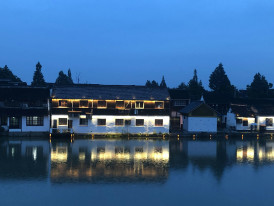
Traditional building reflected in pond at sunset Photo by CHENGKAI LOU on Unsplash
Day Trips: Escaping the City Heat
Sometimes you just need to get out. Lucky for us, Osaka’s location makes it the perfect base for exploring Kansai’s cooler corners. Kyoto, with its rich cultural heritage and scenic beauty, is just a short train ride away and makes for an ideal day trip from Osaka.
Mount Koya: Mountain Temple Retreat
Two hours south by train, Mount Koya sits 900 meters up where the air actually feels breathable. This Buddhist mountain retreat has over 100 temples, and many offer overnight stays with vegetarian monk cuisine that'll change how you think about tofu.
The cemetery walk through towering cedars hits differently in summer. Those trees are centuries old, and their shade creates this natural air conditioning that makes you understand why monks chose this spot for meditation.
Minoh: Waterfall and Beer
Thirty minutes north of central Osaka, Minoh offers the perfect half-day escape. The hike to Minoh Falls takes about 45 minutes through forested paths, and yeah, you'll sweat, but that's what makes the waterfall mist feel so good when you reach it.
The real treat? Minoh Beer Warehouse on your way back. This local brewery crafts some of Japan's best beers, and their summer seasonal wheat beer tastes like liquid gold after that hike. Grab a table on their deck and watch the sun set over the valley.
Imagine Experiencing This for Real
A local can show you the vibe, flavors, and hidden gems up close.
Nara: More Than Just Deer
Forty minutes by train, and you're in ancient capital Nara. Sure, everyone goes for the deer, but in summer, hit up the lesser-known spots. Isuien Garden has strategically placed tea houses where you can sip matcha while looking over ponds that haven't changed in 300 years.
The deer know the deal too, you'll find them lounging in temple shade during peak heat, only emerging for evening feeding times. Smart creatures. Take notes.
Osaka Is More Than Its Checklists
Step into tucked-away places and everyday stories you won’t find on maps.
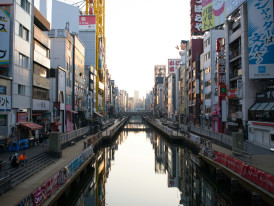
Early morning street scene with golden light and few people Photo by Mario Häfliger on Unsplash
The Local's Summer Survival Guide
After 35 summers here, I've got this down to a science. Here's your cheat sheet:
What to Pack
- Portable fan: Not negotiable. USB rechargeable ones from Don Quijote start from 1,000 yen
- Sweat towel: Every convenience store sells them. Loop it through your belt
- Sunscreen: Japanese brands like Anessa work in humidity
- Change of clothes: Seriously. Pack a fresh shirt in your bag
- Cash: Many places still don't take cards, especially festivals
Your packing list should also include those cooling sheets (stick them on your neck), a collapsible umbrella for sudden storms, and comfortable shoes you don't mind getting wet.
Transportation Hacks
The subway's your best friend in summer. Stations are climate-controlled heavens, and trains blast AC that'll freeze-dry your sweat. Get an ICOCA card at any station, it works on all trains, buses, and even at convenience stores.
Pro tip: The JR Loop Line hits all major spots, and trains come every 3-4 minutes. Miss one? Just wait in the AC. Namba Station and Osaka Station are massive underground cities themselves . You could spend hours shopping without seeing sunlight.
Timing Is Everything
- 6–9 am: Tourist spots, outdoor sightseeing
- 10 am-2 pm: Museums, shopping, long lunches
- 2–5 pm: Spa World, indoor attractions, or hotel pool
- 5 pm onward: Street life, festivals, outdoor dining
Locals take this schedule seriously. You'll notice shops in residential areas often close 2-5 PM in summer. They know what's up.
Hidden Cooling Spots
Every local has their secret AC spots. Mine include:
- Yodobashi Camera Umeda: Massive electronics store where you can "browse" for hours
- Tsutaya Bookstore: The one in Umeda has a cafe with panoramic views
- Kaiyukan Aquarium: Not hidden, but those dark, cool rooms with jellyfish? Paradise
- Any pachinko parlor: I don't gamble, but they have the strongest AC in Japan
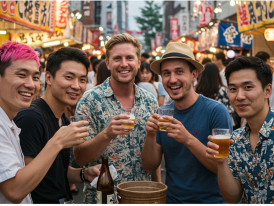
Group of friends sharing drinks at outdoor festival osaka
Why Osaka Summers Beat the Rest
Look, I could move to cooler climates. My wife suggests it every August. But here’s what I’d miss: that moment when you emerge from an ice-cold convenience store onto blazing streets, and the city’s energy hits you like a wall. The way locals nod knowingly when you fan yourself on the train. The shared experience of surviving another Osaka summer together.
This city doesn’t slow down for heat. It adapts, it thrives, it turns obstacles into opportunities for another festival, another cold beer, another reason to gather and celebrate, making it through another day.
The tourists who visit Osaka in cherry blossom season or autumn? They get the postcard version. For travelers, summer in Osaka offers a deeper, more immersive experience, connecting them with the city’s true character and local traditions. But summer? Summer is when you see Osaka’s true character: resilient, innovative, and always ready with a cold drink and a bad joke to make you forget the temperature.
Quick Reference: Must-Do Summer Experiences
For First-Timers
- Osaka Castle at sunrise (before 8 am)
- Tenjin Matsuri (July 24-25)
- Dotonbori night food crawl
- Spa World afternoon escape
- Umeda Sky Building at sunset
For Repeat Visitors
- Minoh Beer Warehouse day trip
- Orange Street evening hangout
- Neighborhood festival hunting
- Underground shopping arcade exploration
- Rooftop beer garden hopping
For Families
- Universal Studios Japan (early or late)
- Osaka Aquarium midday escape
- Nagai Botanical Garden morning visit
- Kids Plaza Osaka (indoor playground)
- Sumiyoshi Taisha evening stroll
For Foodies
- Kuromon Market morning sushi
- Shinsekai kushikatsu dinner
- Hidden sushi at Hozenji Yokocho
- Department store basement food floors
- Late-night ramen in any neighborhood
Essential Japanese Phrases for Summer Survival
Before I wrap this up, let me arm you with some phrases that'll make locals smile and maybe even share their secret cooling spots:
- "Atsui desu ne!" (It's hot, isn't it!) - The universal summer greeting
- "Kūrā ga kikimasu ka?" (Is there air conditioning?) - Your most important question
- "Tsumetai biiru kudasai" (Cold beer please) - Self-explanatory
- "Doko ga suzushii desu ka?" (Where is it cool?) - For finding relief
- "Kakigōri wa doko de kaemasu ka?" (Where can I buy shaved ice?) - Summer essential
Drop any of these at the right moment, and watch how quickly you go from tourist to temporary local. The grandmother fanning herself on the train might even offer you some of her umeboshi (pickled plum) - it's supposed to help with the heat. Whether it actually works or you're just distracted by the face-puckering sourness is up for debate.
Wish You Could Just Ask a Local?
Book a quick video call and get insider answers to your trip questions.
The Bottom Line on Summer in Osaka
Summer here isn’t about comfort, it’s about experience. It’s about earning that cold beer with sweat, discovering that perfect air-conditioned cafe, and understanding why locals love this city even when it tries to melt us.
You want easy? Visit Tokyo in October. You want real? Come to Osaka in July, when the festivals explode, the food tastes better because you’ve earned it, and the city shows you what it’s really made of.
The heat here tests you, sure. But it also bonds you with every other person navigating these steamy streets. We’re all in this sauna together, sharing knowing glances over convenience store coffee, collectively sighing when train doors open to blessed AC, and celebrating sunset like we’ve survived another battle.

Sunset over Osaka cityscape from a high viewpoint photo by wuz-squid-JIeL7TGzjDE on unsplash
Just remember: convenience stores are your friend, beer gardens are your reward, and when an old lady offers you her fan on the train, take it with both hands and bow. That’s Osaka summer culture right there. Visiting shrines like Namba Yasaka Shrine, where the lion’s mouth is said to swallow evil spirits and bring good luck, is also a memorable part of the summer experience.
And hey, if you’re looking for more personalized Osaka experiences, there are ways to explore with locals who know every secret AC spot and hidden gem in this concrete jungle. Though honestly? Get lost on your own first. The best Osaka stories start with “So I was sweating bullets when suddenly…”
Trust me. I’ve got 35 summers’ worth of those stories, and counting.
About the Author
Daiki Morimoto is a born-and-bred Osaka native who writes about food, urban culture, and the art of surviving Japanese summers. When not seeking the city's strongest air conditioning, he can be found at Hanshin Tigers games or arguing about the proper takoyaki-to-sauce ratio.
Planning your Osaka summer adventure? Pin this guide and share your own heat-beating tips in the comments. And if you're curious about things to do in Osaka this winter, well, that's a completely different city. Almost bearable, even.
Ready to Plan Your Perfect Day in Osaka?
Start your experienceWhat If Exploring a City Felt More Personal?
City Unscripted pairs you with someone who lives there, so you can see iconic sights and hidden corners in a way that feels like yours.
Discover the differenceWish You Had a Local Friend in Osaka?
One who knows the city inside out and could plan a private day just for you? Our local hosts do exactly that: no scripts, no tourist traps, just the side of the city most people miss.
